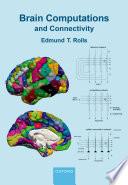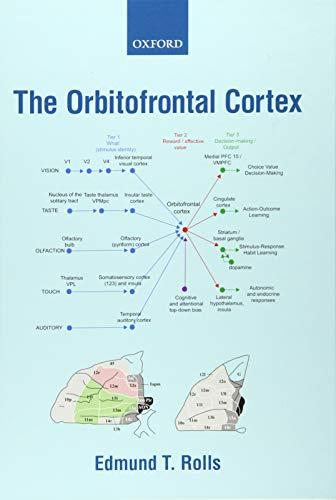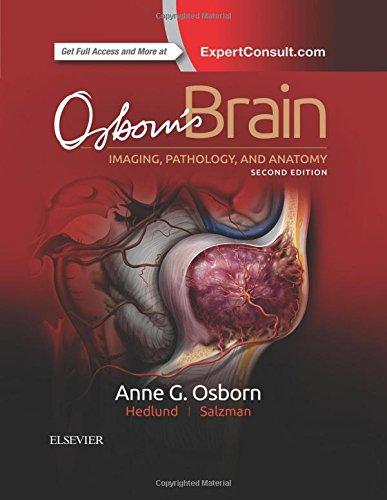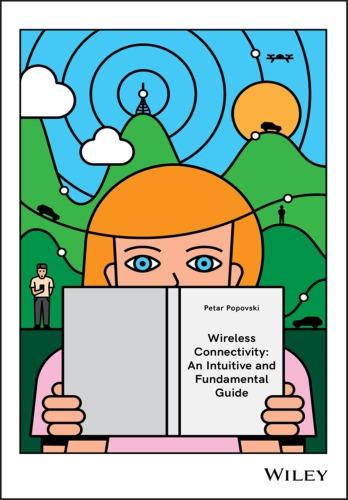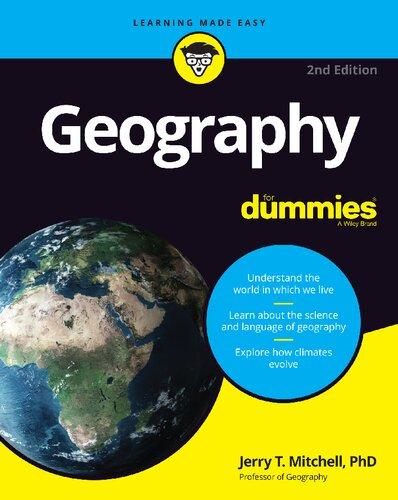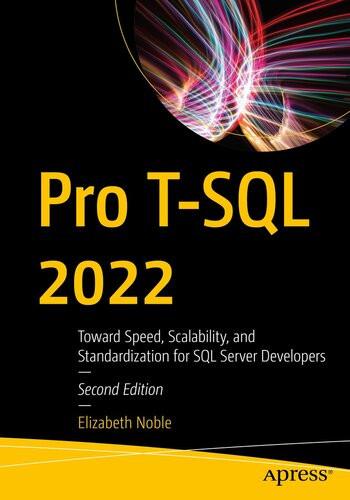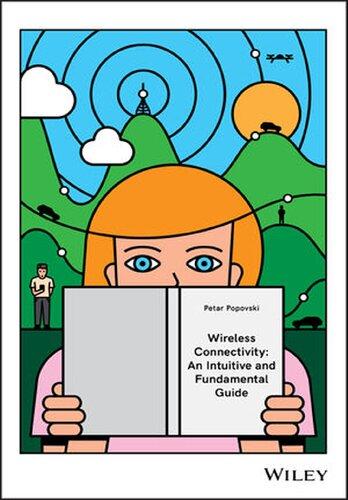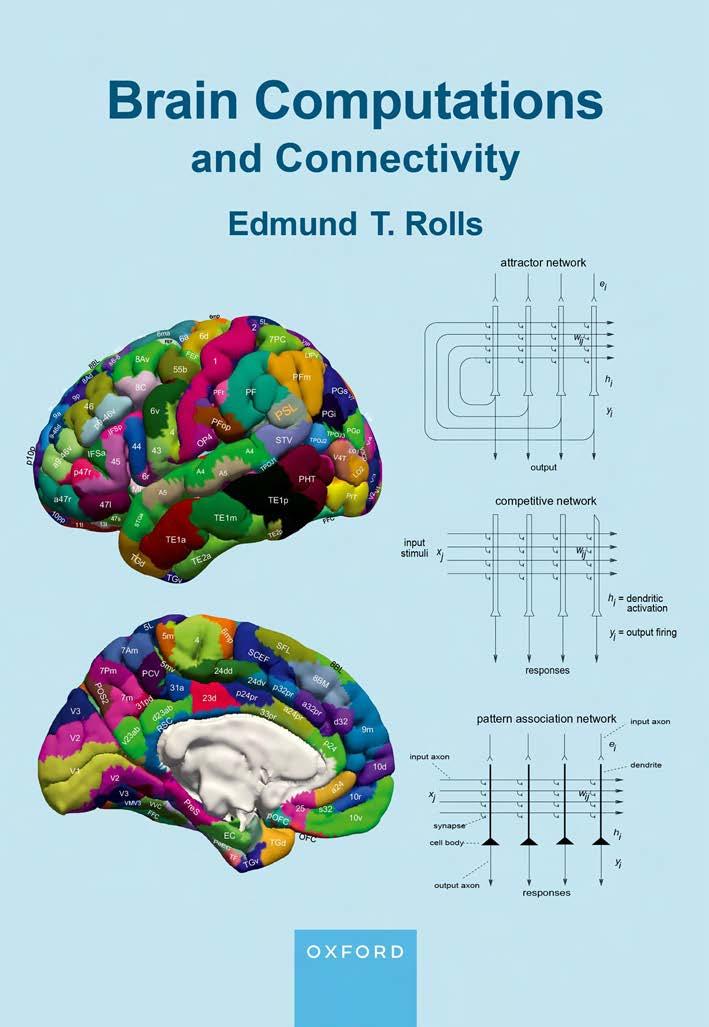BrainComputationsandConnectivity
EdmundT.Rolls
OxfordCentreforComputationalNeuroscience
GreatClarendonStreet,Oxford,OX26DP, UnitedKingdom
OxfordUniversityPressisadepartmentoftheUniversityofOxford. ItfurtherstheUniversity’sobjectiveofexcellenceinresearch,scholarship, andeducationbypublishingworldwide.Oxfordisaregisteredtrademarkof OxfordUniversityPressintheUKandincertainothercountries
c EdmundT.Rolls2023
Themoralrightsoftheauthorhavebeenasserted Somerightsreserved.Nopartofthispublicationmaybereproduced,storedin aretrievalsystem,ortransmitted,inanyformorbyanymeans,forcommercialpurposes, withoutthepriorpermissioninwritingofOxfordUniversityPress,orasexpressly permittedbylaw,bylicenceorundertermsagreedwiththeappropriate reprographicsrightsorganization.
This is an open access publication, available online and distributed under the terms of a Creative Commons Attribution – Non Commercial – No Derivatives 4.0 International licence (CC BY-NC-ND 4.0), a copy of which is available at http://creativecommons.org/licenses/by-nc-nd/4.0/.
Enquiries concerning reproduction outside the scope of this licence should be sent to the Rights Department, Oxford University Press, at the address above
Published in the United States of America by Oxford University Press 198 Madison Avenue, New York, NY 10016, United States of America
British Library Cataloguing in Publication Data Data available
Library of Congress Control Number: 2023940370
ISBN 978–0–19–888791–1
DOI: 10.1093/oso/9780198887911.001.0001
Printed and bound by CPI Group (UK) Ltd, Croydon, CR0 4YY
Links to third party websites are provided by Oxford in good faith and for information only. Oxford disclaims any responsibility for the materials contained in any third party website referenced in this work.
Preface
Thisbook, BrainComputationsandConnectivity isanupdatetoRolls BrainComputations: WhatandHow publishedbyOxfordUniversityPressin2021.Akeypartofthisupdated versionof BrainComputations:WhatandHow istheadditionofmuchnewevidencethat hasemergedsince2021ontheconnectivityofthehumanbrain,whichbyanalysingthe effectiveorcausalconnectivitybetween360corticalregions,enrichesourunderstanding ofinformationprocessingstreamsinthehumancerebralcortex.Knowinghowonecortical regionconnectstoothercorticalregionshelpstoprovideadeeperunderstandingofhow eachstageinaprocessingstreamcontributestothecomputationsbeingperformed,aseach processingstreamisnowbecomingbetterdefined.
Theadditionin BrainComputationsandConnectivity ofmuchnewevidenceontheconnectivityofthehumanbrainisleadingtobetterunderstandingofwhatiscomputedindifferenthumanbrainregions,whichinturnhasimplicationsforhowthecomputationsareperformed.Theaddedemphasisinthisbookontheorganisation,connectivity,andfunctionsof 360corticalregionsinthehumanbrainincreasestheapplicationofnewapproachestakento understandinghowthebrainworksthataredescribedinthisbook,bymakingtheevidence veryrelevanttothehumanbrain,andtherebytothosewhoareinterestedindisordersofthe humanbrain,includingneurologistsandpsychiatrists,aswellastoallthoseinterestedin understandinghowthehumanbrainworksinhealthanddisease.Theenablesthecomputationalapproachestounderstandingbrainfunctiondescribedinthisbooktobecombined withandmadehighlyrelevanttounderstandinghumanbrainfunction.Itishopedthatthese developmentsinunderstandinghumanbrainfunctionbyincludinganalysisoftheconnectivityofthe360corticalregionsintheHumanConnectomeProjectMultimodalParcellation (HCP-MMP)atlas(Glasseretal., 2016a; Huangetal., 2022)asdescribedherewillprovidea foundationforfutureresearchthatbyusingtheHCP-MMPcanberelatedtotheconnectivity andfunctionsofthese360corticalregionsinthehumanbrainthataredescribedinthisbook. Thetitleofthisbook, BrainComputationsandConnectivity,referstotheimportanceofthis typeofconnectivityinunderstandingwhatandhowthebraincomputes.
Anotherfeatureofthisbookisthatitadoptswhatwasdescribedasa‘grandunifying approach’inareviewinthejournal Brain (Manohar, 2022)of BrainComputations:What andHow (Rolls, 2021b)inthatittakesabiologicallyplausibleapproachtohowthebrain computes,ratherthaninvokingtheartificialintelligenceapproachofdeeplearningtotry toaccountforbraincomputation.Theapproachtohowthebraincomputesinthisbookis biologicallyplausibleinthatitutilisesprimarilylocalsynapticmodificationrulestosetup thesynapticconnectionsbetweenneurons,andunsupervisedlearning,yetconsidershowfar thiscantakeusinunderstandinghowthebrainoperates.Thisapproachisquitedifferenttothe deeplearningapproachusednowinmuchmachinelearningandAI,whichbackpropagatesan errorbackwardsthroughthenetworktocorrecteverysynapticweightinallprecedinglayers ofthenetwork,butthereisnoconnectivityinthebrainforthat.Moreover,thelearninginthe brainislargelyunsupervised,whereasdeeplearningapproachestypicallyrequireasupervisor foreachoutputneuron,whichinturnrequireswhatmustbecomputedforeachoutputneuron tobespecifiedbythedesignerofthedeepnetwork.Thepointisdeveloped(inChapter 19) thatmachinelearningmightbenefitfromunderstandingsomeoftheunsupervisedapproaches usedbythebraintosolvecomplexproblems,includingnavigation,attention,semantics,and
evensyntax.Thetitleofthisbook, BrainComputationsandConnectivity,alsoreferstothis conceptthattheactualconnectivityatthelocallevelofneuronsandsynapsesthatisfoundin thebrainisimportantinunderstandingwhatandhowitcomputes.
MyaiminmakingthisbookOpenAccessistomakethescholarshipandideasinthis bookeasilyavailabletocolleagues,intheinterestsofbetterunderstandingthehumanbrain inhealthanddisease.ThisbookcanbecitedasRolls,E.T.(2023) BrainComputations andConnectivity,OxfordUniversityPress,Oxford.Thebookcanbedownloadedfrom https://www.oxcns.org orfromtheOxfordUniversityPresswebsite.Anadvantageofpublicationofthisbookasa.pdfisthatitcontainsextensivehyperlinks,enablingreadersto quicklycross-refertootherpartsofthebookortocitations.Withthe.pdf,figurescanalsobe expandedtoshowdetails.
Manyscientists,andmanyothers,areinterestedinhowthebrainworks.Inordertounderstandthis,weneedtoknow what computationsareperformedbydifferentbrainsystems; and how theyarecomputedbyeachofthesesystems.
Theaimofthisbookistoelucidatewhatiscomputedindifferentbrainsystems;andto describecurrentcomputationalapproachesandmodelsofhoweachofthesebrainsystems computes.
Tounderstandhowourbrainswork,itisessentialtoknow what iscomputedineach partofthebrain.Thatcanbeaddressedbyutilisingevidencerelevanttocomputationfrom manyareasofneuroscience.Knowledgeoftheconnectionsbetweendifferentbrainregions isimportant,forthisshowsthatthebrainisorganisedassystems,withwholeseriesofbrain regionsdevotedforexampletovisualprocessing.Thatprovidesafoundationforexaminingthecomputationperformedbyeachbrainregion,bycomparingwhatisrepresentedina brainregionswithwhatisrepresentedintheprecedingandfollowingbrainregions,using techniquesofforexampleneurophysiologyandfunctionalneuroimaging.Thewaysinwhich effectiveconnectivityisnowavailablefor360corticalregionsareintroducedinChapter1, withtheresultsofthesenewanalysesfoundthroughoutthisbook.Neurophysiologyatthe singleneuronlevelisneededbecausethisisthelevelatwhichinformationistransmitted betweenthecomputingelementsofthebrain,theneurons.Evidencefromtheeffectsofbrain damage,includingthatavailablefromneuropsychology,isneededtohelpunderstandwhat differentpartsofthesystemdo,andindeedwhateachpartisnecessaryfor.Functionalneuroimagingisusefultoindicatewhereinthehumanbraindifferentprocessestakeplace,andto showwhichfunctionscanbedissociatedfromeachother.Soforeachbrainsystem,evidence onwhatiscomputedateachstage,andwhatthesystemasawholecomputes,isessential.
Tounderstandhowourbrainswork,itisalsoessentialtoknow how eachpartofthe braincomputes.Thatrequiresaknowledgeofwhatiscomputedbyeachpartofthebrain, butitalsorequiresknowledgeofthenetworkpropertiesofeachbrainregion.Thisinvolves knowledgeoftheconnectivitybetweentheneuronsineachpartofthebrain,andknowledge ofthesynapticandbiophysicalpropertiesoftheneurons.Italsorequiresknowledgeofthe theoryofwhatcanbecomputedbynetworkswithdefinedconnectivity.
Thereareatleastthreekeygoalsoftheapproachesdescribedhere.Oneistounderstand ourselvesbetter,andhowweworkandthink.Asecondistobebetterabletotreatthesystem whenithasproblems,forexampleinmentalillnesses.Medicalapplicationsareaveryimportantaimofthetypeofresearchdescribedhere.Athird,istobeabletoemulatetheoperation ofpartsofourbrains,whichsomeinthefieldofartificialintelligence(AI)wouldliketodoto produceusefulcomputersthatincorporatesomeoftheprinciplesofcomputationutilisedby thebrain.Allofthesegoalsrequire,andcannotgetofftheground,withoutafirmfoundation inwhatiscomputedbybrainsystems,andtheoriesandmodelsofhowitiscomputed.To understandtheoperationofthewholebrain,itisnecessarytoshowhowthedifferentbrain
systemsoperatetogether:butanecessaryfoundationforthisistoknowwhatiscomputedin eachbrainsystem,andtheconnectivitybetweenthedifferentregionsinvolved.
Partoftheenterprisehereistostimulatenewtheoriesandmodelsofhowpartsofthebrain work.Theevidenceonwhatiscomputedindifferentbrainsystemshadadvancedrapidlyin thelast50years,andprovidesareasonablefoundationfortheenterprise,thoughthereis muchthatremainstobelearned.Theoriesofhowthecomputationisperformedareless advanced,butprogressisbeingmade,andcurrentmodelsaredescribedinthisbookfor manybrainsystems,intheexpectationthatbeforefurtheradvancesaremade,knowledgeof theconsiderablecurrentevidenceonhowthebraincomputesprovidesausefulstartingpoint, especiallyascurrenttheoriesdotakeintoaccountthelimitationsthatarelikelytobeimposed bytheneuralarchitecturespresentinourbrains.Inthisbook,thefocusisonbiologically plausiblealgorithmsforbraincomputation,ratherthanforexampledeeplearningwhichdoes notappeartobehowthebrainlearnsandcomputes(Sections B.12 and B.14).
Thesimplestwaytodelineate braincomputation istoexaminewhatinformationis representedateachstageofprocessing,andhowthisisdifferentfromstagetostage.For exampleintheprimaryvisualcortex(V1),neuronsrespondtosimplestimulisuchasbars oredgesorgratingsandhavesmallreceptivefields.Littlecanbereadofffromthefiring ratesaboutforexamplewhosefaceisrepresentedfromasmallnumberofneuronsinV1. Ontheotherhand,afterfourorfivestagesofprocessing,intheinferiortemporalvisual cortex,informationcanbereadfromthefiringratesofneuronsaboutwhosefaceisbeing viewed,andindeedthereisremarkableinvariancewithrespecttotheposition,size,contrast andeveninsomecasesviewoftheface.Thatisamajorcomputation,andindicateswhatcan beachievedbybiologicalneuronalnetworkcomputation.
Theseapproachescanonlybetakentounderstandbrainfunctionbecausethereisconsiderablelocalizationoffunctioninthebrain,quiteunlikeadigitalcomputer.Onefundamental reasonforlocalizationoffunctioninthebrainisthatthisminimizesthetotallengthofthe connectionsbetweenneurons,andthusbrainsize.Anotheristhatitsimplifiesthegenetic informationthathastobeprovidedinordertobuildthebrain,becausetheconnectivityinstructionscanreferconsiderablytolocalconnections.Thesepointsaredevelopedinmybook CerebralCortex:PrinciplesofOperation (Rolls, 2016b).
Thatbringsmetowhatisdifferentaboutthepresentbookand CerebralCortex:PrinciplesofOperation (Rolls, 2016b). CerebralCortex:PrinciplesofOperation tookonthe enormoustaskofmakingprogresswithunderstandinghowthemajorpartofourbrains,the cerebralcortex,works,byunderstandingitsprinciplesofoperation.Thepresentbookbuilds onthatapproach,andusesitasbackground,buthasthedifferentaimoftakingeachofour brainsystems,anddescribing what theycompute,andthenwhatisknownabout how each systemcomputes.Theissueofhowtheycomputereliesformanybrainsystemsonhowthe cortexoperates,so CerebralCortex:PrinciplesofOperation providesanimportantcomplementtothepresentbook.
Withitsfocusonwhatandhoweachbrainsystemcomputes,afieldthatincludescomputationalneuroscience,thisbookisdistinctfromthemanyexcellentbooksonneuroscience thatdescribemuchevidenceaboutbrainstructureandfunction,butdonotaimtoprovidean understandingofhowthebrainworksatthecomputationallevel.Thisbookaimstoforgean understandingofhowsomekeybrainsystemsmayoperateatthecomputationallevel,sothat wecanunderstandhowthebrainactuallyperformssomeofitscomplexandnecessarilycomputationalfunctionsinmemory,perception,attention,decision-making,cognitivefunctions, andactions.
Indeed,asoneofthekeyaimsofthisbookistodescribe whatcomputations areperformedbydifferentbrainsystems,Ihavechosentoincludeinthisbooksomeofthekeyactual discoveriesinneurosciencethatIbelievehelptodefinewhatcomputationsareperformedin
differentbrainsystems.Partoftheaimofcitingtheoriginalpioneeringdiscoveriesistoshow howconceptualadvanceshavebeenmadeinourunderstandingofwhatiscomputedineach regionofourbrains,forunderstandingthekeydiscoveriesprovidesafoundationforfurther advances.
Thatmakesthisbookverydifferentfrommanyofthetextbooksofneuroscience(such as PrinciplesofNeuralScience (Kandeletal., 2021)),andsomeofthetextbooksoftheoreticalneurosciencethatdescribeprinciplesofoperationofneuronsorofnetworksofneurons (DayanandAbbott, 2001; Hertzetal., 1991; Gerstneretal., 2014),butnotingeneralwhat iscomputedindifferentbrainsystems,andhowitiscomputed.Further,therearelikelytobe greatdevelopmentsinourunderstandingof how thebraincomputes,andthisbookisintended tosetoutaframeworkfornewdevelopments,byprovidingananalysisofwhatiscomputed bydifferentbrainsystems,andprovidingsomecurrentapproachestohowthesecomputations maybeperformed.Ibelievethatthisbook,anditspredecessor BrainComputations:What andHow,ispioneeringinwhatIproposeisthenecessaryapproachtounderstandingbrain function,understanding‘What’iscomputedbyeachbrainregion,and‘How’itiscomputed.
Atestofwhetherone’sunderstandingiscorrectistosimulatetheprocessingonacomputer,andtoshowwhetherthesimulationcanperformthetasksperformedbythebrain,and whetherthesimulationhassimilarpropertiestotherealbrain.Thisapproachtoneuralcomputationleadstoaprecisedefinitionofhowthecomputationisperformed,andtoprecise andquantitativetestsofthetheoriesproduced.Howmemorysystemsinthebrainworkisa paradigmexampleofthisapproach,becausememory-likeoperationswhichinvolvealtered functionalityasaresultofsynapticmodificationareattheheartofhowmanycomputationsin thebrainareperformed.Ithappensthatattentionanddecision-makingcanbeunderstoodin termsofinteractionsbetweenandfundamentaloperationsinmemorysystemsinthecortex, andthereforeitisnaturaltoaddresstheseareasofcognitiveneuroscienceinthisbook.The samefundamentalconceptsbasedontheoperationofneuronalcircuitrycanbeappliedtoall thesefunctions,asisshowninthisbook.
Oneofthedistinctivepropertiesofthisbookisthatitlinkstheneuralcomputationapproachnotonlyfirmlytoneuronalneurophysiology,whichprovidesmuchoftheprimarydata abouthowthebrainoperates,butalsotopsychophysicalstudies(forexampleofattention); toneuropsychologicalstudiesofpatientswithbraindamage;andtofunctionalmagneticresonanceimaging(fMRI)(andotherneuroimaging)approaches.Theempiricalevidencethat isbroughttobearislargelyfromnon-humanprimatesandfromhumans,becauseoftheconsiderablesimilarityoftheircorticalsystems,andthemajordifferencesintheirsystems-level computationalorganizationfromthatofrodents,assetoutinSection 19.10
Anotherfeatureofthebookisthatitaimstodescribetheprinciplesofoperationofthe brain,andindoingthat,frequentlyreferstotheoriginalresearchinwhichthoseprinciples werediscovered.AnotherfeatureofthebookisthatIhavealsochosentomakeeachChapter relativelyunderstandableonitsown,whichmayinvolvesomeinformationalsopresentin otherpartsofthebook,sothatreaderswithaninterestinonepartofthebraincanbenefitby readingtherelevantchapters,ratherthannecessarilyhavingtoreadthewholebook.
Theoverallaimsofthebookaredevelopedfurther,andtheplanofthebookisdescribed, inChapter 1.Appendix B describesthefundamentaloperationofkeynetworksofthetype thatarelikelytobethebuildingblocksofbrainfunction.Appendix C describesquantitative, informationtheoretic,approachestohowinformationisrepresentedinthebrain,whichisan essentialframeworkforunderstandingwhatiscomputedinabrainsystem,andhowitiscomputed.Appendix D describesMatlabsoftwarethathasbeenmadeavailablewiththisbook toprovidesimpledemonstrationsoftheoperationofsomekeyneuronalnetworksrelatedto corticalfunction;toshowhowtheinformationrepresentedbyneuronscanbemeasured;and toprovideatutorialversionoftheVisNetprogramforinvariantvisualobjectrecognition
describedinChapter 2.TheneuralnetworksprogramsarealsoprovidedinPython.Theprogramsareavailableat https://www.oxcns.org
Partofthematerialdescribedinthebookreflectsworkperformedincollaborationwith manycolleagues,whosetremendouscontributionsarewarmlyappreciated.Thecontributions ofmanywillbeevidentfromthereferencescitedinthetext.Especialappreciationisdue toAlessandroTreves,GustavoDeco,SylviaWirth,andSimonM.Stringer,whohavecontributedgreatlyinalwaysinterestingandfruitfulresearchcollaborationsoncomputational andrelatedaspectsofbrainfunction,andtomanyneurophysiologyandfunctionalneuroimagingcolleagueswhohavecontributedtotheempiricaldiscoveriesthatprovidethefoundationtowhichthecomputationalneurosciencemustalwaysbecloselylinked,andwhose namesarecitedthroughoutthetext.CharlNing(UniversityofWarwick)isthankedforhelp withtranslatingtheMatlabneuralnetworkprogramsdescribedinAppendix D intoPython. DrPatrickMillsandImogenKrusearethankedforveryhelpfulcommentsonanearlierversionofthisbook.Muchoftheworkdescribedwouldnothavebeenpossiblewithoutfinancial supportfromanumberofsources,particularlytheMedicalResearchCounciloftheUK,the HumanFrontierScienceProgram,theWellcomeTrust,andtheJamesS.McDonnellFoundation.IamalsogratefultomanycolleagueswhoIhaveconsultedwhilewritingthisbook.The GatsbyFoundationisthankedforagranttowardsthecostofmakingthisbookOpenAccess. ThebookwastypesetbytheauthorusingLATEXandWinEdt.
Updatestoand.pdfsofmanyofthepublicationscitedinthisbookareavailableat https://www.oxcns.org.Updatesandcorrectionstothetextandnotesarealsoavailableat https://www.oxcns.org.
Idedicatethisworktotheoverlappinggroup:myfamily,friends,andcolleagues–insalutem praesentium,inmemoriamabsentium.
1.14.1Thefinestructureandconnectivityoftheneocortex
1.14.4Quantitativeaspectsofcorticalarchitecture
1.14.5Functionalpathwaysthroughthecorticallayers
2Theventralvisualsystem
2.1Introductionandoverview
2.1.1Introduction
2.1.2Overviewofwhatiscomputedintheventralvisualsystem
2.1.3Overviewofhowcomputationsareperformedintheventralvisualsystem
2.1.4Whatiscomputedintheventralvisualsystemisunimodal,andisrelatedto other‘what’systemsaftertheinferiortemporalvisualcortex
2.2What:V1–primaryvisualcortex
2.3What:V2andV4–intermediateprocessingareasintheventralvisualsystem
2.4What:Invariantrepresentationsoffacesandobjectsintheinferiortemporalvisual
2.4.1Rewardvalueisnotrepresentedintheprimateventralvisualsystem
2.4.2Translationinvariantrepresentations
2.4.3Reducedtranslationinvarianceinnaturalscenes
2.4.4Sizeandspatialfrequencyinvariance
2.4.5Combinationsoffeaturesinthecorrectspatialconfiguration
2.4.6Aview-invariantrepresentation
2.4.7Learningintheinferiortemporalcortex
2.4.8Asparsedistributedrepresentationiswhatiscomputedintheventralvisual system
2.4.9Faceexpression,gesture,andview
2.4.10Specializedregionsinthetemporalcorticalvisualareas
2.5Theconnectivityoftheventralvisualpathwaysinhumans
2.5.1AVentrolateralVisualCorticalStreamtotheinferiortemporalvisualcortex forobjectandfacerepresentations 86
2.5.2AVisualCorticalStreamtothecortexintheinferiorbankofthesuperior temporalsulcusinvolvedinsemanticrepresentations 89
2.5.3AVisualCorticalStreamtothecortexinthesuperiorbankofthesuperior temporalsulcusinvolvedinmultimodalsemanticrepresentationsincludingvisualmotion,auditory,somatosensoryandsocialinformation 89
2.6Howthecomputationsareperformed:approachestoinvariantobjectrecognition
2.6.1Featurespaces
2.6.2Structuraldescriptionsandsyntacticpatternrecognition
2.6.3Templatematchingandthealignmentapproach
2.6.4Invertiblenetworksthatcanreconstructtheirinputs
2.6.5Deeplearning
2.6.6Featurehierarchies
2.7Hypothesesabouthowthecomputationsareperformedinafeaturehierarchyapproach
2.8VisNet:amodelofhowthecomputationsareperformedintheventralvisualsystem
2.8.1ThearchitectureofVisNet
2.8.2InitialexperimentswithVisNet
2.8.3Theoptimalparametersforthetemporaltraceusedinthelearningrule
2.8.4Differentformsofthetracelearningrule,anderrorcorrection
2.8.5Theissueoffeaturebinding,andasolution 134
2.8.6Operationinaclutteredenvironment
2.8.7Learning3Dtransforms
2.8.8Capacityofthearchitecture,andanattractorimplementation 159
2.8.9Visioninnaturalscenes–effectsofbackgroundversusattention 162
2.8.10Therepresentationofmultipleobjectsinascene 170
2.8.11Learninginvariantrepresentationsusingspatialcontinuity 172
2.8.12Lightinginvariance 173
2.8.13Deformation-invariantobjectrecognition 175
2.8.14Learninginvariantrepresentationsofscenesandplaces 176
2.8.15Findingandrecognisingobjectsinnaturalscenes 178
2.8.16Non-accidentalproperties,andtransforminvariantobjectrecognition 181
2.9Furtherapproachestoinvariantobjectrecognition 183
2.9.1Othertypesofslowlearning 183
2.9.2HMAX 183
2.9.3Minimalrecognizableconfigurations 188
2.9.4Hierarchicalconvolutionaldeepneuralnetworks 189
2.9.5Sigma-Pisynapses 190
2.9.6Aprincipaldimensionsapproachtocodingintheinferiortemporalvisual cortex 190
2.10Visuo-spatialscratchpadmemory,andchangeblindness 192
2.11Processesinvolvedinobjectidentification 194
2.12Top-downattentionalmodulationisimplementedbybiasedcompetition 195
2.13Highlightsonhowthecomputationsareperformedintheventralvisualsystem 198
3Thedorsalvisualsystem 201
3.1Introduction,andoverviewofthedorsalcorticalvisualstream 201
3.2Globalmotioninthedorsalvisualsystem 202
3.3Invariantobject-basedmotioninthedorsalvisualsystem 204
3.4Whatiscomputedinthedorsalvisualsystem:visualcoordinatetransforms 206
3.4.1Thetransformfromretinaltohead-basedcoordinates 207
3.4.2Thetransformfromhead-basedtoallocentricbearingcoordinates 208
3.4.3Atransformfromallocentricbearingcoordinatestoallocentricspatialview coordinates 209
3.5Howvisualcoordinatetransformsarecomputedinthedorsalvisualsystem 211
3.5.1Gainmodulation 211
3.5.2Mechanismsofgainmodulationusingatracelearningrule 211
3.5.3Gainmodulationbyeyepositiontoproduceahead-centeredrepresentation inLayer1ofVisNetCT 213
3.5.4Gainmodulationbyheaddirectiontoproduceanallocentricbearingtoa landmarkinLayer2ofVisNetCT 214
3.5.5GainmodulationbyplacetoproduceanallocentricspatialviewrepresentationinLayer3ofVisNetCT 215
3.5.6Theutilityofthecoordinatetransformsinthedorsalvisualsystem 216
3.6ThehumanDorsalVisualCorticalStream 217
3.6.1Dorsalstreamvisualdivisionregions 217
3.6.2MT+complexregions(FST,LO1,LO2,LO3,MST,MT,PH,V3CDandV4t) 218
3.6.3Intraparietalsulcusposteriorparietalcortex,regions(AIP,LIPd,LIPv,MIP, VIP;withIP0,IP1andIP2) 219
3.6.4Area7regions 220
4Thetasteandflavorsystem
221
4.1Introductionandoverview 221
4.1.1Introduction 221
4.1.2Overviewofwhatiscomputedinthetasteandflavorsystem 221
4.1.3Overviewofhowcomputationsareperformedinthetasteandflavorsystem 223
4.2Tasteandrelatedpathways:whatiscomputed 223
4.2.1Hierarchicallyorganisedanatomicalpathways 223
4.2.2Tasteneuronaltuningbecomemoreselectivethroughthetastehierarchy 226
4.2.3Theprimary,insular,tastecortexrepresentswhattasteispresentandits intensity 228
4.2.4Thesecondary,orbitofrontal,tastecortex,anditsrepresentationofthe rewardvalueandpleasantnessoftaste 229
4.2.5Sensory-specificsatietyiscomputedintheorbitofrontalcortex 231
4.2.6Oraltextureisrepresentedintheprimaryandsecondarytastecortex:viscosityandfattexture 234
4.2.7Visionandolfactionconvergeusingassociativelearningwithtastetorepresentflavorinthesecondarybutnotprimarytastecortex 236
4.2.8Top-downattentionandcognitioncanmodulatetasteandflavorrepresentationsinthetastecorticalareas 238
4.2.9Thetertiarytastecortexintheanteriorcingulatecortexprovidestherewards foraction-rewardoutcomelearning 240
4.2.10Taste,oraltextureandflavorprovidetherewardsforeating,andthegut providessatietysignals 241
4.3Tasteandrelatedpathways:howthecomputationsareperformed 245
4.3.1Increasedselectivityoftasteandflavorneuronsthroughthehierarchyby competitivelearningandconvergence 245
4.3.2Patternassociationlearningofassociationsofvisualandolfactorystimuli withtaste 245
4.3.3Rule-basedreversalofvisualtotasteassociationsintheorbitofrontalcortex 246
4.3.4Sensory-specificsatietyisimplementedbyadaptationofsynapsesonto orbitofrontalcortexneurons 246
4.3.5Top-downcognitiveandattentionalmodulationisimplementedbybiased activation 247
5.1Introduction
251
5.1.1Overviewofwhatiscomputedintheolfactorysystem 251
5.1.2Overviewofhowthecomputationsareperformedintheolfactorysystem 252
5.2Whatiscomputedintheolfactorysystem
253
5.2.11000gene-encodedolfactoryreceptortypes,and1000corresponding glomerulustypesintheolfactorybulb 253
5.2.2Theprimaryolfactory,pyriform,cortex:olfactoryfeaturecombinationsare whatisrepresented 255
5.2.3Orbitofrontalcortex:olfactoryneuronalresponseselectivity 256
5.2.4Orbitofrontalcortex:olfactorytotasteconvergence 257
5.2.5Orbitofrontalcortex:olfactorytotasteassociationlearningandreversal 257
5.2.6Orbitofrontalcortex:olfactoryrewardvalueisrepresented 259
5.2.7Cognitiveinfluencesonolfactoryrepresentationsintheorbitofrontalcortex 260
5.3Howcomputationsareperformedintheolfactorysystem
262
5.3.1Olfactoryreceptors,andtheolfactorybulb 262
5.3.2Olfactory(pyriform)cortex 263
5.3.3Orbitofrontalcortex 267
6Thesomatosensorysystem
6.1Whatiscomputedinthesomatosensorysystem
6.1.1Thereceptorsandperiphery
6.1.2Theanteriorsomatosensorycortex,areas1,2,3a,and3b,intheanterior parietalcortex
6.1.3Theventralsomatosensorystream:areasS2andPV,inthelateralparietal cortex
6.1.4Thedorsalsomatosensorystreamtoarea5andthen7b,intheposterior parietalcortex
6.1.5Somatosensoryrepresentationsintheinsula
6.1.6Somatosensoryandtemperatureinputstotheorbitofrontalcortex,affective value,pleasanttouch,andpain 272
6.1.7Decision-makinginthesomatosensorysystem
6.1.8Somatosensorycorticalregionsandconnectivityinhumans
6.2Howcomputationsareperformedinthesomatosensorysystem
6.2.1Hierarchicalcomputationinthesomatosensorysystem
6.2.2Computationsforpleasanttouchandpain
6.2.3Themechanismsforsomatosensorydecision-making
7Theauditorysystem
7.1Introduction,andoverviewofcomputationsintheauditorysystem
7.2AuditoryLocalization
7.3Ventralanddorsalcorticalauditorypathways
7.4Theventralcorticalauditorystream
7.5Thedorsalcorticalauditorystream
7.6Auditorycorticalregionsandconnectivityinhumans
7.6.1EarlyAuditorycorticalregions
7.6.2Ventralauditorycorticalstreams
7.6.3Dorsalauditorycorticalstreams
7.6.4Otherauditorysystemcorticalconnectivities
7.7Howthecomputationsareperformedintheauditorysystem
8Thetemporalcortex
8.1Introductionandoverview
8.2Middletemporalgyrusandfaceexpressionandgesture
8.3Semanticrepresentationsinthetemporallobeneocortex
8.3.1Neurophysiologyofthemedialtemporallobe,includingconceptcells
8.3.2Neuropsychology 303
8.3.3Functionalneuroimaging
8.3.4Brainstimulation
8.4Connectivityandfunctionsofthehumantemporalloberegionsrelatedtosemantics 305
8.4.1Group1semanticregionsthatincluderegionsintheventralbankofthe SuperiorTemporalSulcus 306
8.4.2Group3semanticregionsthatincluderegionsinthedorsalbankofthe SuperiorTemporalSulcus 309
8.5Themechanismsforsemanticlearninginthehumananteriortemporallobe 311 9Thehippocampus,memory,andspatialfunction 313
9.1Introductionandoverview 313
9.1.1Overviewofwhatiscomputedbythehippocampalsystem 313
9.1.2Overviewofhowthecomputationsareperformedbythehippocampalsystem 315
9.2Whatiscomputedinthehippocampus
9.2.1Systems-levelanatomy 316
9.2.2Evidencefromtheeffectsofdamagetothehippocampus 319
9.2.3Episodicmemoriesneedtoberecalledfromthehippocampus,andcanbe usedtohelpbuildneocorticalsemanticmemories 321
9.2.4Systems-levelneurophysiologyoftheprimateincludinghumanhippocampus 324
9.2.5Spatialviewcellsinprimatesincludinghumans,andfovealvision
9.2.6Headdirectioncellsinthepresubiculum 344
9.2.7Perirhinalcortex,recognitionmemory,andlong-termfamiliaritymemory
9.2.8Connectivityofthehumanhippocampalsystem 353
9.3Howcomputationsareperformedinthehippocampalsystem
9.3.1Historicaldevelopmentofthetheoryofthehippocampus
9.3.2Hippocampalcircuitry
9.3.3Medialentorhinalcortex,spatialprocessingstreams,andgridcells
9.3.4Lateralentorhinalcortex,objectprocessingstreams,andthegenerationof timecellsinthehippocampus 372
9.3.5CA3asanautoassociationmemory 378
9.3.6Dentategranulecells 397
9.3.7CA1cells
9.3.8Backprojectionstotheneocortex,memoryrecall,andconsolidation 405
9.3.9Backprojectionstotheneocortex–quantitativeaspects 409
9.3.10Simulationsofhippocampaloperation 413
9.3.11Thelearningofspatialviewandplacecellrepresentations 414
9.3.12Linkingtheinferiortemporalvisualcortextospatialviewandplacecells 416
9.3.13Ascientifictheoryoftheartofmemory:scientiaartismemoriae 418
9.3.14Hownavigationisperformed 419
9.3.15Navigationalcomputationsusingneurontypesfoundinprimatesincluding humans 423
9.4Testsofthetheoryofhippocampalcortexoperation 432
9.4.1Dentategyrus(DG)subregionofthehippocampus 432
9.4.2CA3subregionofthehippocampus 435
9.4.3CA1subregionofthehippocampus 442
9.5Comparisonofspatialprocessingandcomputationsinprimatesincludinghumansvs rodents 445
9.5.1Similaritiesanddifferencesbetweenthespatialrepresentationsinprimates androdents 445
9.5.2Hippocampalcomputationalsimilaritiesanddifferencesbetweenprimates androdents 447
9.6Synthesis:thehippocampus:memory,navigation,orboth? 450
9.7Comparisonwithothertheoriesofhippocampalfunction 454
10Theparietalcortex,spatialfunctions,andnavigation 459
10.1Introductionandoverview 459
10.1.1Overviewofwhatiscomputedintheparietalcortex 459
10.1.2Overviewofhowthecomputationsareperformedintheparietalcortex 460
10.2Inferiorparietalcortexsomatosensorystream,PFregions 460
10.3Intraparietalsulcusposteriorparietalcortex,regionsAIP,LIPd,LIPv,MIP,VIP,IP0, IP1,andIP2 464
10.4Posteriorsuperiorparietalcortex,regions7AL,7Am,7PC,7PL,and7Pm 466
10.5Inferiorparietalcortex,visualregionsPFm,PGi,PGsandPGp 467
10.5.1RegionPGi
10.5.2RegionPGs
10.5.3RegionPFm
10.5.4RegionPGp 471
10.6Navigation:Whatcomputationsareperformedintheparietalandrelatedcortex 473
10.7Howthecomputationsareperformedintheparietalcortex 474
11Theorbitofrontalcortex,amygdala,rewardvalue,emotion,and decision-making
11.1Introductionandoverview
11.1.3Overviewofhowthecomputationsareperformedbytheorbitofrontalcortex 478
11.2Thetopologyandconnectionsoftheorbitofrontalcortex
11.2.2Outputsoftheorbitofrontalcortex
11.3Whatiscomputedintheorbitofrontalcortex 483
11.3.1Theorbitofrontalcortexrepresentsrewardvalue
11.3.2Neuroeconomicvalueisrepresentedintheorbitofrontalcortex 490
11.3.3Arepresentationoffaceandvoiceexpressionandothersociallyrelevant stimuliintheorbitofrontalcortex 492
11.3.4Negativerewardpredictionerrorneuronsintheorbitofrontalcortex 495
11.3.5Thehumanmedialorbitofrontalcortexrepresentsrewards,andthelateral orbitofrontalcortexnon-rewardandpunishers 500 11.3.6Decision-makingintheorbitofrontal/ventromedialprefrontalcortex 502 11.3.7Theventromedialprefrontalcortexandmemory 504
11.3.8Theorbitofrontalcortexandemotion 506
11.3.9Emotionalorbitofrontalvsrationalroutestoaction 508
11.3.10Theconnectivityofthehumanorbitofrontalcortex,anditsrelationtofunction 521
11.3.11Mentalproblemsassociatedwiththeorbitofrontalcortex 528
11.4Whatiscomputedintheamygdalaforemotion 529
11.4.1Overviewofthefunctionsoftheamygdalainemotion 529
11.4.2Theamygdalaandtheassociativeprocessesinvolvedinemotion-related learning 530
11.4.3Connectionsoftheamygdala 531
11.4.4Effectsofamygdalalesions 532
11.4.5Amygdalalesionsinprimates 532
11.4.6Amygdalalesionsinrats 534
11.4.7Neuronalactivityintheprimateamygdalatoreinforcingstimuli 535
11.4.8Neuronalresponsesintheamygdalatofaces 536
11.4.9Evidencefromhumans 538
11.4.10Connectivityofthehumanamygdala 539
11.5Howthecomputationsareperformedintheorbitofrontalcortex 544
11.5.1Decision-makinginattractornetworksinthebrain 544
11.5.2Analysesofreward-relateddecision-makingmechanismsintheorbitofrontal cortex 549
11.5.3Amodelforreversallearningintheorbitofrontalcortex 554
11.5.4Atheoryandmodelofnon-rewardneuralmechanismsintheorbitofrontal cortex 559
11.6Highlights:thespecialcomputationalrolesoftheorbitofrontalcortex 560
12Thecingulatecortex 564
12.1Introductiontoandoverviewofthecingulatecortex 564
12.1.1Introduction 564
12.1.2Overviewofwhatiscomputedinthecingulatecortex 565
12.1.3Overviewofhowthecomputationsareperformedbythecingulatecortex 567
12.2Anteriorcingulatecortex 568
12.2.1Anteriorcingulatecortexanatomyandconnectionsinprimates 568
12.2.2Anteriorcingulatecortex:Aframework 569
12.2.3Anteriorcingulatecortexandaction-outcomerepresentations 571
12.2.4Anteriorcingulatecortexlesioneffects 572
12.2.5Anteriorcingulatecortexandventromedialprefrontalcortexconnectivityand functionsinhumans 572
12.2.6Pregenualanteriorcingulaterepresentationsofrewardvalue,andsupracallosalanteriorcingulaterepresentationsofpunishersandnon-reward 575
12.2.7Thehumansupracallosalanteriorcingulatecortex,dACC,andactionoutcomelearning 578
12.2.8Rewardvalueoutputsfromtheorbitofrontalandpregenualanteriorcortex, andvmPFC,tothehippocampalmemorysystem 579
12.2.9Thepregenualanteriorcingulatecortexhasconnectivitywiththeseptal cholinergicsystemthatisinvolvedinmemoryconsolidation 579
12.2.10Rewardvalueoutputsfromtheorbitofrontalandpregenualanteriorcortex, andvmPFC,tothehippocampalsystemtoprovidethegoalsfornavigation 580
12.2.11Subgenualcingulatecortex 581
12.3Posteriorcingulatecortex 581
12.3.1Introductionandoverview 581
12.3.2Postero-ventralposteriorcingulateandmedialparietalregions31pd,31pv, d23ab,v23aband7m,andtheirrelationtoepisodicmemory 582
12.3.3Antero-dorsalPosteriorCingulateDivisionregions23d,31a,PCV;andRSC, POS2,andPOS1;andtheirrelationtonavigationandexecutivefunction 584
12.3.4DorsalVisualTransitionalareaandProStriateregion:theretrosplenialscene area 587
12.4Mid-cingulatecortex,thecingulatemotorarea,andaction–outcomelearning 588
12.5Howthecomputationsareperformedbythecingulatecortex 589
12.5.1Theanteriorcingulatecortexandemotion 589
12.5.2Action-outcomelearninginthesupracallosalanteriorcingulatecortex (dACC) 590
12.5.3Connectivityoftheposteriorcingulatecortexwiththehippocampalmemory system 592
12.6Synthesisandconclusions 593
13.2Divisionsofthelateralprefrontalcortex 600
13.2.1Thedorsolateralprefrontalcortex 600
13.2.2Thecaudalprefrontalcortex 603
13.2.3Theventrolateralprefrontalcortex 603
13.3Theconnectivityandcomputationalorganisationofthehumanprefrontalcortex 603
13.3.1Inferiorfrontalgyrus 604
13.3.2Dorsolateralprefrontalcortexdivision 606
13.4Thelateralprefrontalcortexandtop-downattention 609
13.5Thefrontalpolecortex 612
13.6Howthecomputationsareperformedintheprefrontalcortex 613
13.6.1Corticalshort-termmemorysystemsandattractornetworks 613
13.6.2Prefrontalcortexshort-termmemorynetworks,andtheirrelationtoperceptualnetworks 615
13.6.3Mappingfromonerepresentationtoanotherinshort-termmemory 620
13.6.4Themechanismsoftop-downattention 621
13.6.5Computationalnecessityforaseparate,prefrontalcortex,short-termmemorysystem 622
13.6.6Synapticmodificationisneededtosetupbutnottoreuseshort-termmemory systems 623
13.6.7Sequencememory 623
13.6.8Workingmemory,andplanning 623
14Languageandsyntaxinthebrain 624
14.1Introductionandoverview 624
14.1.1Introduction 624
14.1.2Overview 624
14.2Whatiscomputedindifferentbrainsystemstoimplementlanguage 626
14.2.1TheWernicke-Lichtheim-Geschwindhypothesis 626
14.2.2Thedual-streamhypothesisofspeechcomprehension 627
14.2.3Readingrequiresdifferentbrainsystemstohearingspeech 627
14.2.4Semanticrepresentations 629
14.2.5Syntacticprocessing 630
14.2.6Theparietalcortex:supramarginalandangulargyri 631
14.3Corticalregionsforlanguageandtheirconnectivityinhumans 631
14.3.1Asemanticsystemthatincludestheinferiorbankofthesuperiortemporal sulcusincludingobjectrepresentations 632
14.3.2Asemanticsystemthatincludesthesuperiorbankofthesuperiortemporalsulcusincludingvisualmotion,auditory,somatosensoryandsocial information 634
14.3.3Multimodalsemanticrepresentations 635
14.3.4Broca’sareaandrelatedregions(TGv444547lSFL55b) 637
14.4Hypothesesabouthowsemanticrepresentationsarecomputed 640
14.5Aneurodynamicalhypothesisabouthowsyntaxiscomputed 641
14.5.1Bindingbysynchrony? 641
14.5.2Syntaxusingaplacecode 642
14.5.3Temporaltrajectoriesthroughastatespaceofattractors 642
14.5.4Hypothesesabouttheimplementationoflanguageinthecerebralcortex 643
14.5.5Testsofthehypotheses–amodel 646
14.5.6Testsofthehypotheses–findingswiththemodel 651
14.5.7Evaluationofthehypotheses 654
14.5.8Furtherapproaches 658
15.1Introductionandoverview
15.2Whatiscomputedindifferentcorticalmotor-relatedareas 661
15.2.1VentralparietalandventralpremotorcortexF4 661
15.2.2Superiorparietalareaswithactivityrelatedtoreaching 661
15.2.3Inferiorparietalareaswithactivityrelatedtograsping,andventralpremotor cortexF5 662
15.3Themirrorneuronsystem 662
15.4Howthecomputationsareperformedinmotorcorticalandrelatedareas 664
16Thebasalganglia
16.1Introductionandoverview
16.2Systems-levelarchitectureofthebasalganglia 666
16.3Whatcomputationsareperformedbythebasalganglia? 669
16.3.1Effectsofstriatallesions 669
16.3.2Neuronalactivityindifferentpartsofthestriatum 670
16.4Howdothebasalgangliaperformtheircomputations? 683
16.4.1Interactionbetweenneuronsandselectionofoutput 683
16.4.2Convergencewithinthebasalganglia,usefulforstimulus-responsehabit learning 686
16.4.3Dopamineasarewardpredictionerrorsignalforreinforcementlearningin thestriatum 688
16.5Comparisonofcomputationsforselectioninthebasalgangliaandcerebralcortex 692
17Cerebellarcortex
17.1Introduction
17.2Architectureofthecerebellum 697
17.2.1TheconnectionsoftheparallelfibresontothePurkinjecells 697
17.2.2TheclimbingfibreinputtothePurkinjecell 698
17.2.3Themossyfibretogranulecellconnectivity 698
17.3ModifiablesynapsesofparallelfibresontoPurkinjecelldendrites
17.4Thecerebellarcortexasaperceptron
17.5Cognitivefunctionsofthecerebellum
17.5.1Anatomicalconnectionsfrommostneocorticalregions 702
17.5.2Functionalconnectivityofdifferentcorticalsystemswithdifferentpartsof thecerebellum 703
17.5.3Activationofdifferentcerebellarcorticalregionsindifferenttasks 703
17.5.4Damagetodifferentpartsofthecerebellumcanproducedifferentcognitive, emotional,andmotorimpairments 703
17.5.5Neocortical–cerebellarcorticalcomputationsforcognition 703
17.6Highlights:differencesbetweencerebralandcerebellarcortexmicrocircuitry 707
18.1Introductionandoverview
18.2Thenoisycortex
18.2.1Reasonswhythebrainisinherentlynoisyandstochastic
18.2.2Attractornetworks,energylandscapes,andstochasticneurodynamics 714
18.2.3Amultistablesystemwithnoise 719
18.2.4Stochasticdynamicsandthestabilityofshort-termmemory 721
18.2.5Stochasticdynamicsindecision-making,andtheevolutionaryutilityofprobabilisticchoice 725
18.2.6Selectionbetweenconsciousvsunconsciousdecision-making,andfreewill 726
18.2.7Stochasticdynamicsandcreativethought 728
18.2.8Stochasticdynamicsandunpredictablebehavior 729
18.3Attractordynamicsandschizophrenia 729
18.3.1Introduction 729
18.3.2Adynamicalsystemshypothesisofthesymptomsofschizophrenia 730
18.3.3Reducedfunctionalconnectivityofsomebrainregionsinschizophrenia 733
18.3.4Beyondthedisconnectivityhypothesisofschizophrenia:reducedforward butnotbackwardconnectivity 734
18.4Attractordynamicsandobsessive-compulsivedisorder 738
18.4.1Introduction 738
18.4.2Ahypothesisaboutobsessive-compulsivedisorder 739
18.4.3Glutamateandincreaseddepthofthebasinsofattraction 741
18.5Depressionandattractordynamics 742
18.5.1Introduction
18.5.2Anon-rewardattractortheoryofdepression
18.5.3Theorbitofrontalcortex,andthetheoryofdepression
18.5.4Alteredconnectivityoftheorbitofrontalcortexindepression
18.5.5Activationsoftheorbitofrontalcortexrelatedtodepression
18.5.6Implications,andpossibletreatments,andsubtypesofdepression
18.5.7Maniaandbipolardisorder
18.6Attractorstochasticdynamics,aging,andmemory
18.6.1NMDAreceptorhypofunction
18.6.2Dopamineandnorepinephrine
18.6.3Impairedsynapticmodification
18.6.4Cholinergicfunctionandmemory
18.7Highbloodpressure,reducedhippocampalfunctionalconnectivity,andimpaired memory
18.8Braindevelopment,andstructuraldifferencesinthebrain
19.1Introductionandoverview
19.2Computationsthatcombinedifferentcomputationalsystemsinthebraintoproduce behavior
19.3Braincomputationcomparedtocomputationonadigitalcomputer
19.4Braincomputationcomparedwithartificialdeeplearningnetworks
19.5ReinforcementLearning
19.6Levelsofexplanation,andthemind-brainproblem
19.6.1Alevelsofexplanationtheoryofcausality,andtherelationbetweenthemind andthebrain
19.6.2DownwardorUpwardCausality?
19.6.3Consciousness-aHigherOrderSyntacticThoughttheory
19.6.4Levelsofexplanation,andlevelsofinvestigation
19.7Biologicallyplausiblecomputationinthebrain:agrandunifyingtheory?
19.8Brain-InspiredIntelligence
19.9.1Computationalpsychiatryandneurology
19.9.2Rewardsystemsinthebrain,andtheirapplicationtounderstandingfood intakecontrolandobesity
19.9.3MultipleRoutestoAction
19.10Primatesincludinghumanshavedifferentbrainorganisationthanrodents 796
19.10.1Thevisualsystem 796
19.10.2Thetastesystem 797
19.10.3Theolfactorysystem 798
19.10.4Thesomatosensorysystem 798
19.10.5Theauditorysystem 799
19.10.6Thehippocampalsystem,memory,andnavigation 799
19.10.7Theorbitofrontalcortexandamygdala 800
19.10.8Thecingulatecortex 801
19.10.9Themotorsystem 802 19.10.10Language 802
AIntroductiontolinearalgebraforneuralnetworks 803
A.1Vectors 803
A.1.1Theinnerordotproductoftwovectors 803
A.1.2Thelengthofavector 805
A.1.3Normalizingthelengthofavector 805
A.1.4Theanglebetweentwovectors:thenormalizeddotproduct 805
A.1.5Theouterproductoftwovectors 806
A.1.6Linearandnon-linearsystems 807
A.1.7Linearcombinations,linearindependence,andlinearseparability 808
A.2Applicationtounderstandingsimpleneuralnetworks 809
A.2.1Capabilityandlimitationsofsingle-layernetworks 810
A.2.2Non-linearnetworks:neuronswithnon-linearactivationfunctions 812
A.2.3Non-linearnetworks:neuronswithnon-linearactivations 813
BNeuronalnetworkmodels 815
B.1Introduction 815
B.2Patternassociationmemory 815
B.2.1Architectureandoperation 816
B.2.2Asimplemodel 818
B.2.3Thevectorinterpretation 821
B.2.4Properties 822
B.2.5Prototypeextraction,extractionofcentraltendency,andnoisereduction 825
B.2.6Speed 825
B.2.7Locallearningrule 826
B.2.8Implicationsofdifferenttypesofcodingforstorageinpatternassociators 831
B.3Autoassociationorattractormemory 832
B.3.1Architectureandoperation 832
B.3.2Introductiontotheanalysisoftheoperationofautoassociationnetworks 834
B.3.3Properties 836
B.3.4Dilutedconnectivityandthestoragecapacityofattractornetworks 843
B.3.5Useofautoassociationnetworksinthebrain 854
B.4Competitivenetworks,includingself-organizingmaps 855
B.4.1Function 855
B.4.2Architectureandalgorithm 856
B.4.3Properties 857
B.4.4Utilityofcompetitivenetworksininformationprocessingbythebrain 862
B.4.5Guidanceofcompetitivelearning 864
B.4.6Topographicmapformation 866
B.4.7Invariancelearningbycompetitivenetworks 870
B.4.8RadialBasisFunctionnetworks 871
B.4.9Furtherdetailsofthealgorithmsusedincompetitivenetworks 873
B.5Continuousattractornetworks 876
B.5.1Introduction 876
B.5.2Thegenericmodelofacontinuousattractornetwork 878
B.5.3Learningthesynapticstrengthsinacontinuousattractornetwork 879
B.5.4Thecapacityofacontinuousattractornetwork:multiplecharts 881
B.5.5Continuousattractormodels:pathintegration 882
B.5.6Stabilizationoftheactivitypacketwithinacontinuousattractornetwork 884
B.5.7Continuousattractornetworksintwoormoredimensions 886
B.5.8Mixedcontinuousanddiscreteattractornetworks 887
B.6Networkdynamics:theintegrate-and-fireapproach 888
B.6.1Fromdiscretetocontinuoustime 888
B.6.2Continuousdynamicswithdiscontinuities 889
B.6.3Anintegrate-and-fireimplementation 893
B.6.4Thespeedofprocessingofattractornetworks 894
B.6.5Thespeedofprocessingofafour-layerhierarchicalnetwork 897
B.6.6Spikeresponsemodel 900
B.7Networkdynamics:introductiontothemean-fieldapproach 901
B.8Mean-fieldbasedneurodynamics 902
B.8.1Populationactivity 903
B.8.2Themean-fieldapproachusedinamodelofdecision-making 905
B.8.3Themodelparametersusedinthemean-fieldanalysesofdecision-making 907
B.8.4Abasiccomputationalmodulebasedonbiasedcompetition 908
B.8.5Multimodularneurodynamicalarchitectures 909
B.9Interactingattractornetworks 911
B.10Sequencememoryimplementedbyadaptationinanattractornetwork 915
B.11Errorcorrectionnetworks 915
B.11.1Architectureandgeneraldescription 916
B.11.2Genericalgorithmforaone-layererrorcorrectionnetwork 916
B.11.3Capabilityandlimitationsofsingle-layererror-correctingnetworks 917
B.11.4Properties 920
B.12Errorbackpropagationmultilayernetworks 922
B.12.1Introduction 922
B.12.2Architectureandalgorithm 923
B.12.3Propertiesofmultilayernetworkstrainedbyerrorbackpropagation 927
B.13Deeplearningusingstochasticgradientdescent 928
B.14Deepconvolutionalnetworks 928
B.15ContrastiveHebbianlearning:theBoltzmannmachine 930
B.16DeepBeliefNetworks 931
B.17Reinforcementlearning 932
B.17.1Associativereward–penaltyalgorithmofBartoandSutton 933
B.17.2Rewardpredictionerrorordeltarulelearning,andclassicalconditioning 934
B.17.3TemporalDifference(TD)learning 935
B.18Learningintheneocortex 938
B.19Forgettingincorticalassociativeneuralnetworks,andmemoryreconsolidation 940
B.20Genesandself-organizationbuildneuralnetworksinthecortex 945
B.20.1Introduction 945
B.20.2Hypothesesaboutthegenesthatbuildcorticalneuralnetworks 946
B.20.3Geneticselectionofneuronalnetworkparameters 950
B.20.4Simulationoftheevolutionofneuralnetworksusingageneticalgorithm 952
B.20.5Evaluationofthegene-basedevolutionofsingle-layernetworks 961
B.20.6Thegene-basedevolutionofmulti-layercorticalsystems 964
B.20.7Summary 965
C.1Informationtheory 968
C.1.1Theinformationconveyedbydefinitestatements 968
C.1.2Informationconveyedbyprobabilisticstatements 969
C.1.3Informationsources,informationchannels,andinformationmeasures 970
C.1.4Theinformationcarriedbyaneuronalresponseanditsaverages 971
C.1.5Theinformationconveyedbycontinuousvariables 974
C.2Theinformationcarriedbyneuronalresponses 976
C.2.1Thelimitedsamplingproblem 976
C.2.2Correctionproceduresforlimitedsampling 977
C.2.3Theinformationfrommultiplecells:decodingprocedures 978
C.2.4Informationinthecorrelationsbetweencells:adecodingapproach 982
C.2.5Informationinthecorrelationsbetweencells:secondderivativeapproach 987
C.3Neuronalencodingresults 990
C.3.1Thesparsenessofthedistributedencodingusedbythebrain 991
C.3.2Theinformationfromsingleneurons 1002
C.3.3Theinformationfromsingleneurons:temporalcodesversusratecodes 1005
C.3.4Theinformationfromsingleneurons:thespeedofinformationtransfer 1008
C.3.5Theinformationfrommultiplecells:independenceversusredundancy 1019
C.3.6Shouldoneneuronbeasdiscriminativeasthewholeorganism? 1023
C.3.7Theinformationfrommultiplecells:theeffectsofcross-correlations 1025
C.3.8Conclusionsoncorticalneuronalencoding 1029
C.4Informationtheoryterms–ashortglossary 1033
C.5Highlights 1034
DSimulationsoftwareforneuronalnetworks,andinformationanalysis ofneuronalencoding 1035
D.1Introduction 1035
D.2Autoassociationorattractornetworks 1036
D.2.1Runningthesimulation 1036
D.2.2Exercises 1038
D.3Patternassociationnetworks 1038
D.3.1Runningthesimulation 1038
D.3.2Exercises 1040
D.4CompetitivenetworksandSelf-OrganizingMaps 1041
D.5Furtherdevelopments 1043
D.6MatlabcodeforatutorialversionofVisNet 1043
D.7Matlabcodeforinformationanalysisofneuronalencoding 1044
D.8Matlabcodetoillustratetheuseofspatialviewcellsinnavigation 1044
D.9TheAutomatedAnatomicalLabellingAtlas3,AAL3 1044
D.10TheextendedHumanConnectomeProjectextendedatlas,HCPex 1044
